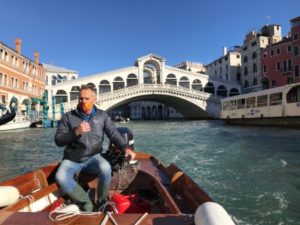
This past year Jeremy Pal, Loyola Marymount University professor of civil and environmental engineering, found himself directly experiencing the effects of climate change as he stood knee-deep in the acqua alta, or high waters, flooding into Venice when the newly operational flood gates were opened.
Pal, who has authored groundbreaking studies focused on understanding climate change and its impacts around the world over the past 20 years, sought to nudge his work in a slightly different direction during his recent yearlong sabbatical—gaining a better understanding of climate change adaptation and mitigation strategies.
“Even though we have the Paris agreement, little progress seems to have been made to shift from our current business-as-usual path,” he explains. “As the impacts of climate change are becoming better understood, a recently developing research area has been in adaptation measures that can help our communities become more climate change resilient. In response, I’ve started to shift my work from trying to understand the problem and the impacts towards figuring out how to solve or mitigate the problem and adapt to it.”
Pal worked at the Venice-based Risk Assessment and Adaptation Strategies Division at the Euro-Mediterranean Centre on Climate Change during his sabbatical. There, an interdisciplinary team of economists, environmental scientists/engineers and spatial planners analyze and assess climate risk, adaptation strategies, and policies.
“We’re assessing the benefits of implementing various adaptation strategies,” Pal explains. In one project, Pal works with researchers to develop and implement a novel stakeholder driven storyline concept about different effects of climate change and how they impact European sustainability, policy and trade. For example, how might a hurricane in the U.S. curtail shipping to and from Europe, or a drought in Ethiopia provoke migration to Europe?

“Another project I’ve just started working on is an environmental risk and economic impact assessment of climate in Venice and the surrounding lagoons. Venice is threatened by rising sea levels and is at the same time sinking, and more and more frequently flooded and slowly disappearing underwater. Activating the recently installed flood gates called MOSE, protects the city from flooding, but there’s a big economic impact when they’re closed, as it, for example, shuts down shipping traffic.”
“It put things into perspective for me to see what it is like without the flood gates,” says Pal. “People were ecstatic when they worked the first time, and many are optimistic that they’ll save the city. Venice is a city that is already adapting to climate change as a means of survival.”
Pal appreciates the differences in project approach between the U.S. and Europe. “In the U.S., projects tend to be smaller and more focused with fewer partners,” says Pal. “In the European Union, the projects are much larger, focused more on the big picture and making big impacts, and involve many partners including stakeholders. The projects are already implementing adaptation solutions on local city levels to make communities climate resilient with the aim to scale them up to European and even global levels.”
Venice is a dream city for Pal, and he’s long been interested in working with the Centre. Plus, his wife is Italian, and her parents live close to Venice, although they’ve been prevented from visiting because of COVID-19. Pal also finds the location of his sabbatical slightly ironic since he was born and raised in Venice, California.



